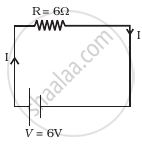Advertisements
Advertisements
प्रश्न
Why alloys like constantan and manganin are used for making standard resistors?
उत्तर
Alloys like constantan and manganin are used for making standard resistors because
(a) they have high value of resistivity
(b) temperature cofficient of resistance is less
संबंधित प्रश्न
Estimate the average drift speed of conduction electrons in a copper wire of cross-sectional area 1.0 × 10−7 m2 carrying a current of 1.5 A. Assume the density of conduction electrons to be 9 × 1028 m−3
The number density of free electrons in a copper conductor is 8.5 × 1028 m−3. How long does an electron take to drift from one end of a wire 3.0 m long to its other end? The area of cross-section of the wire is 2.0 × 10−6 m2 and it is carrying a current of 3.0 A.
Consider the following statements.
(A) Free-electron density is different in different metals.
(B) Free-electron density in a metal depends on temperature.
Peltier Effect is caused _______________ .
When a current I is set up in a wire of radius r, the drift velocity is vd· If the same current is set up through a wire of radius 2 r, the drift velocity will be:
Is the momentum conserved when charge crosses a junction in an electric circuit? Why or why not?
The relaxation time τ is nearly independent of applied E field whereas it changes significantly with temperature T. First fact is (in part) responsible for Ohm’s law whereas the second fact leads to variation of ρ with temperature. Elaborate why?
- Consider circuit in figure. How much energy is absorbed by electrons from the initial state of no current (ignore thermal motion) to the state of drift velocity?
- Electrons give up energy at the rate of RI2 per second to the thermal energy. What time scale would one associate with energy in problem (a)? n = no of electron/volume = 1029/m3, length of circuit = 10 cm, cross-section = A = (1mm)2

A potential difference (V) is applied across a conductor of length 'L' and cross-sectional area 'A'.
How will the drift velocity of electrons and the current density be affected if another identical conductor of the same material were connected in series with the first conductor? Justify your answers.
Two conductors, made of the same material have equal lengths but different cross-sectional areas A1 and A2 (A1 > A2). They are connected in parallel across a cell. Show that the drift velocities of electrons in two conductors are equal.
The drift velocity of electrons in a conductor connected to a battery is given by vd = `(−"eE" τ)/"m"`. Here, e is the charge of the electron, E is the electric field, τ is the average time between collisions and m is the mass of the electron.
Based on this, answer the following:
- How does the drift velocity change with a change in the potential difference across the conductor?
- A copper wire of length 'l' is connected to a source. If the copper wire is replaced by another copper wire of the same area of cross-section but of length '4l', how will the drift velocity change? Explain your answer.
